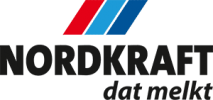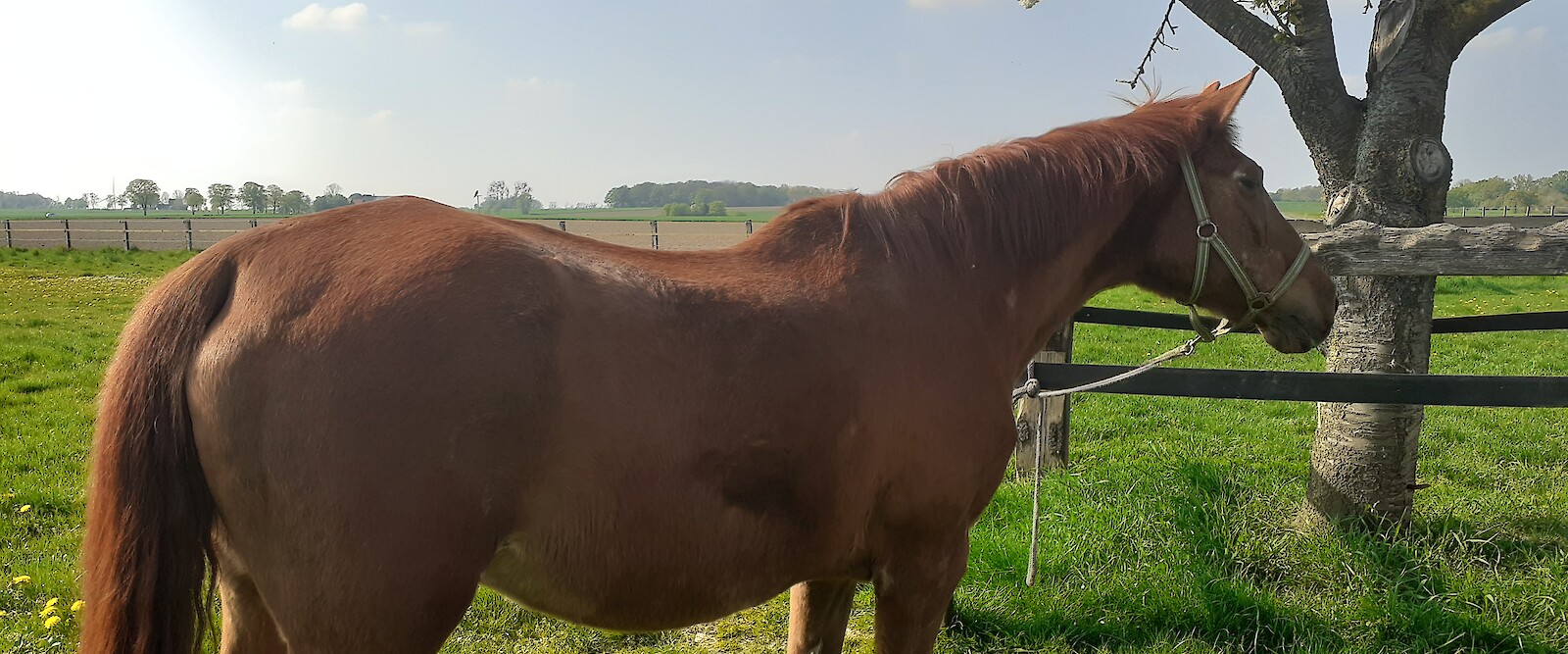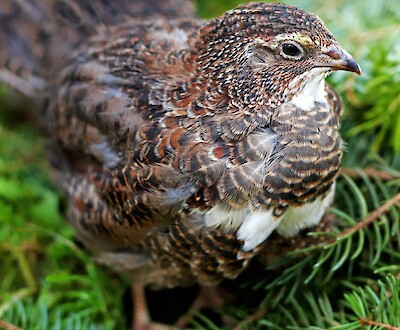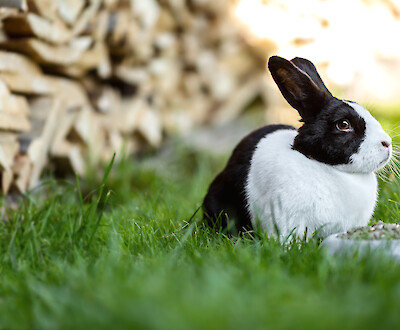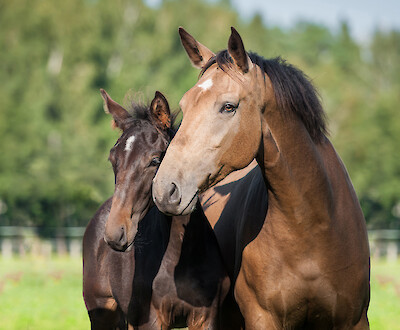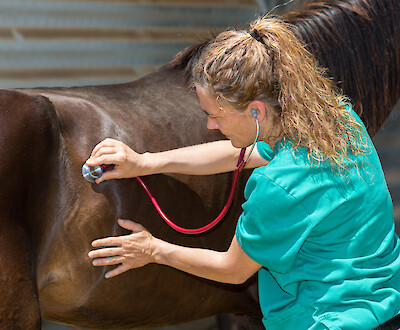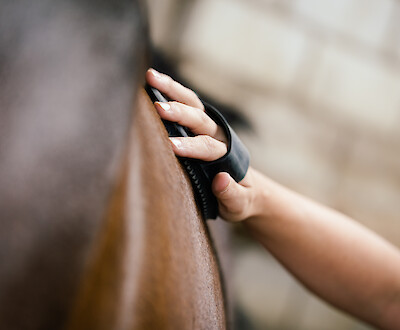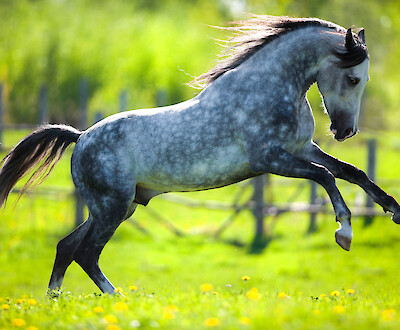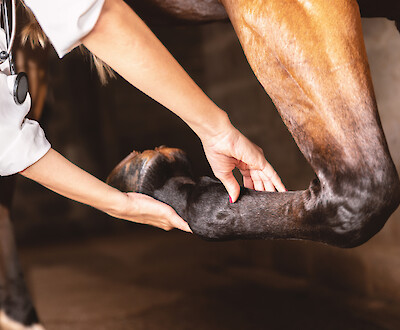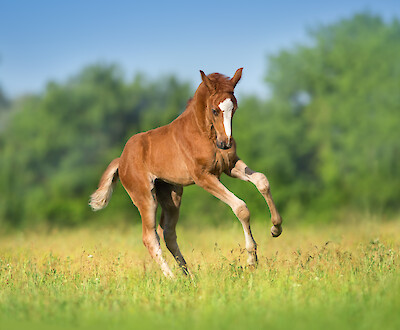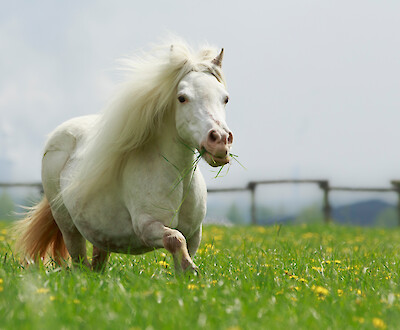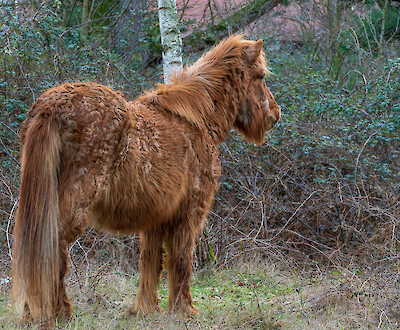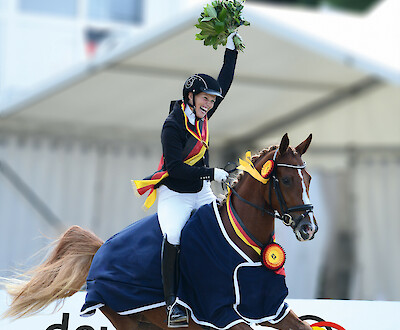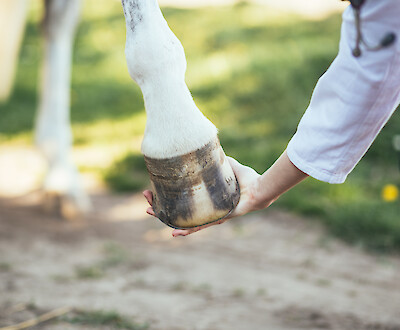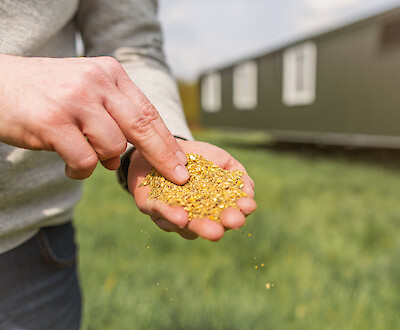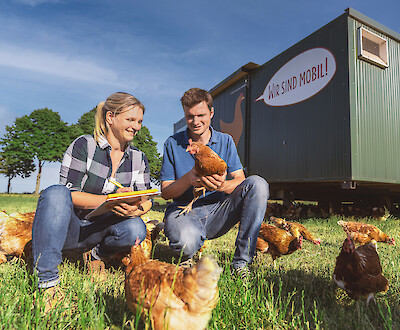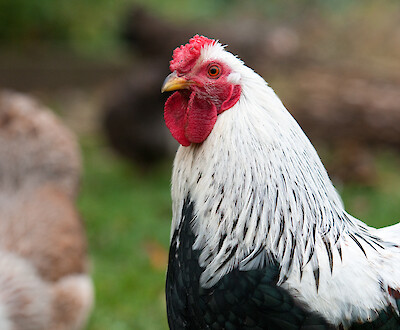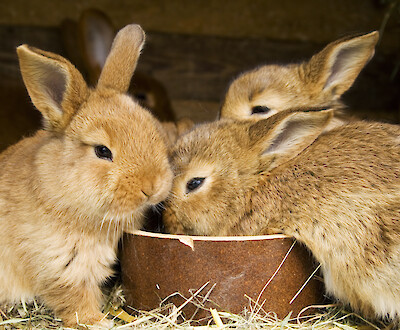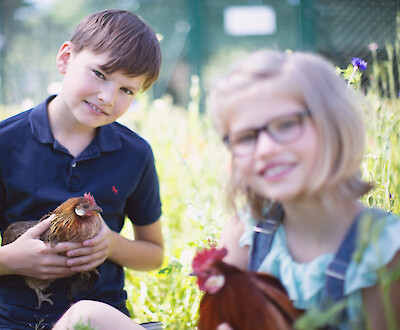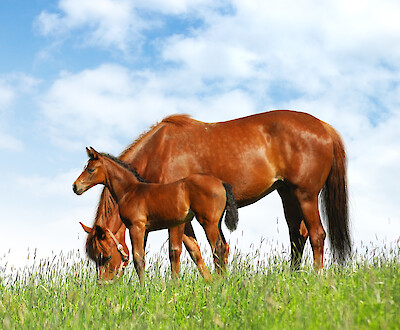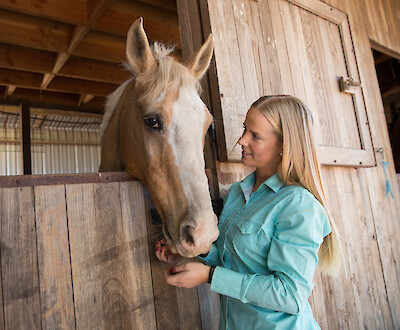Constipation colic often comes as a complete surprise to horses. What usually begins with discomfort can suddenly turn into a life-threatening condition. Horse owners should take the first signs seriously and act quickly to prevent worse. Once the acute phase is over, a highly digestible feed that keeps the digestion going and replenishes lost energy depots helps the horse to recover. Ration components that support the daily water intake are also useful now. The example of Welfe - Angela Romberg's aged warmblood mare - shows how to act correctly in case of constipation colic.
When Angela Romberg took over Welfe, the warmblood mare was in her prime. At the age of 13, she was in the prime of her life. At just under 1.60 metres, the proud lady horse was not the tallest - but she was very fit, energetic and spirited. The robust and active m are went through thick and thin with her owner in the years to come. Both travelled through Alsace, the south of France and actively shaped their lives. 22 years ago.
Challenge: Constipation colic in horses usually comes unexpectedly
Usually, warmblood breeds like Hanoverian, Trakehner or Oldenburg live to be 20 - 25 years old, but not Welfe. Lots of love, regular rides and good food kept the mare healthy and vital until she was 35 years old. But it was not always clear that this would happen. In March 2020, Mrs Romberg observed something worrying: Welfe suddenly stopped eating and drinking. After an anxious wait and the obligatory examination at the vet, it was finally clear: constipation colic!
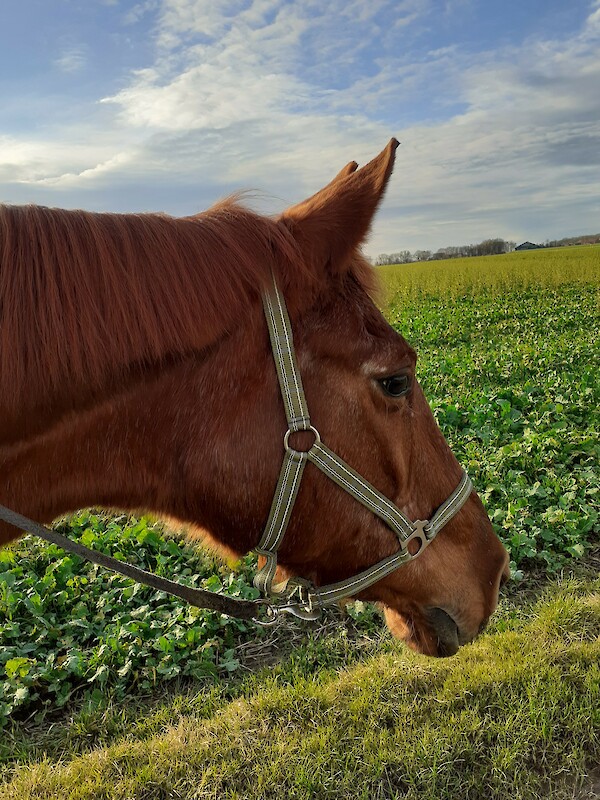
Background: What is constipation colic in horses?
Colic is one of the most dreaded ailments of the horse. The term "colic" describes not so much a specific disease as a complex of different symptoms. What they all have in common is pain in the horse's chest and abdomen. Depending on the cause and severity, one distinguishes between cramp colic, gas colic, sand colic or constipation colic. However, the condition often takes a life-threatening course after it begins seemingly harmlessly with simple indisposition.
Symptoms of constipation colic in horses
Constipation colic is usually manifested by abdominal pain, loss of appetite or the absence of bowel movements. Affected horses breathe faster, turn towards their belly and lie down more often. Quick help is needed from a veterinarian.
Causes of constipation colic in horses
Constipation colic in horses is usually caused by unsuitable feeding or too little water intake Wateringestion, which leads to a clumping of the food. This is the case, for example, if the horse feeds exclusively on straw, eats grass that has been chopped too short, or drinks too little. This form of constipation is also called constipation. Even rarer than constipation is obturation. This is constipation caused by ingestion of a foreign body (e.g. stones).
Constipation colic in horses: What to do? Adapt feeding!
If the symptoms point to constipation colic, horse owners must react quickly and correctly - after all, the disease can be life-threatening. Therefore, the most important thing now is to talk to the veterinarian. In the acute phase, depending on where the constipation is located and how long it has been present, antispasmodic medication, fluid infusions or paraffin oil via a nasopharyngeal tube can help. Depending on the severity, surgery is sometimes the last resort to save the horse. The reason for this: The horse is usually no longer able to excrete the hardened food mush on its own.
Constipation colic takes its toll. Once the acute episode is over, the most important thing is to feed the horse up again and give it back its lost strength. This can be achieved with an adapted, tailor-made care:
-
Water in sufficient quantity supports a smooth digestion of the horse. The cool water helps to soften the solid mash and facilitates the transport and elimination of the hard mash.
But be careful: The actual water intake from self-watering troughs is difficult to control. Therefore, during the regeneration phase, you should additionally offer lukewarm water in portions in buckets. This makes it easier to keep track and ensures sufficient water intake. 30 - 40 litres: This is the amount of water that adult horses (large horses) should drink daily during light work.
-
Hard stalk food and constipation? That does not go together! Therefore, straw does not belong on a horse's menu after it has recovered from constipation colic. Instead, you should switch to alternative bedding such as shavings or flax bedding.
-
The be-all and end-all is a supply of high-quality hay in sufficient quantity (at least 1.5 kg / 100 kg body weight and day). The long-stalked fibre of meadow hay keeps horses busy through intensive chewing. At the same time, it forms the basis of a well-functioning digestion. The additional administration of hay cobs can be a useful supplement to hay feeding. In this way, the raw fibre content of the ration can be further increased. Soaked hay cobs also provide an additional source of fluid - an excellent way to offer the horse additional water during the regeneration phase of a constipation colic.
-
Constipation colic takes its toll. Due to pain, stress and reduced feed intake, horses suffering from colic sometimes rapidly lose body mass. They lose strength, vigour and energy. Once the colic has been overcome and the concentrate intake increased, it makes sense to supplement the ration with special restorative feeds. They help to refill the energy stores.
Solution: After the constipation colic Welfe came back to life with the right feeding
Angela Romberg reacted quickly and in an exemplary manner to Welfe's constipation colic. After the vet's acute intervention, it was important to prevent a relapse. Mrs Romberg supplemented Welfe's feeding with deukavallo hay cobs. Soaked in plenty of liquid, it supported the much needed water intake. The hay supplement, made from dried meadow grass, is rich in plant fibres that swell on contact with water and thus bind fluid.
Due to constipation colic, Welfe had lost a lot of substance and was visibly emaciated. To give Welfe back her strength, Mrs Romberg changed her mare's ration to a special restorative feed deukavallo Top InForm is a highly digestible special feed for horses with increased energy and protein requirements. The horse feed is optimally suited for feeding and caring for heavy-fed, underweight and older horses. It provides optimally usable energy and valuable protein building blocks to rebuild lost body mass. With Welfe, the worst was over after just a few weeks.
Angela RombergThe vet couldn't believe it: only a short time after the change of feed, Welfe galloped happily whinnying in the pasture. She had recovered magnificently and her coat was also more beautiful than ever after the change of coat - which went as quickly and smoothly as never before.
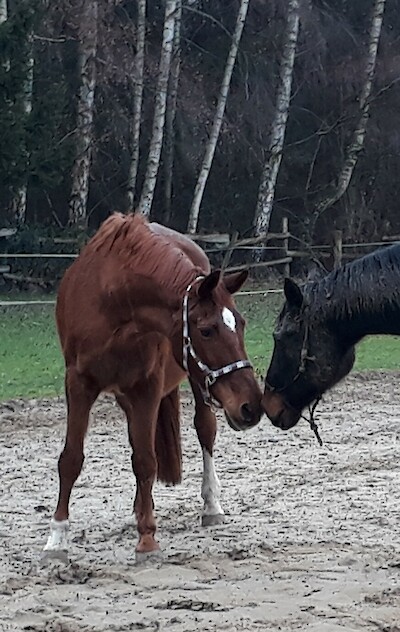
Outlook: Preventing constipation colic in horses - prophylaxis is essential
Constipation colic can be caused by incorrect feeding or ingestion of indigestible foreign bodies. What a horse eats cannot be controlled around the clock. But with the right feed you can prevent constipation colic. These tips can help:
- Pay attention to feed quality: The basis for this is high-quality basic feed (straw and hay) - fermented ration components such as haylage or silage can lead to problems.
- An adequate supply of hay prevents the intake of high amounts of straw from the litter. Make sure that feeding breaks are as short as possible and that fresh hay is always available in the rack.
- Your horse should receive its concentrate (pellets, muesli) only after the hay ration. This improves its digestion.
- If your feed ration contains cereals, feed them - if possible - in broken down and thus easily digestible form. Appropriate horse feeds contain hydrothermally broken down and therefore particularly digestible ingredients. Your horse should eat many small portions instead of a few large ones. Too large amounts of feed can clump together more easily.
Angeal RombergI am particularly fussy about the food I feed my Guelphs. I pay a lot of attention to the quality of all ingredients and do not change the ration lightly. Since I have been feeding deukavallo, I am extremely satisfied with my mare's feed.
Image sources: © Angela Romberg


